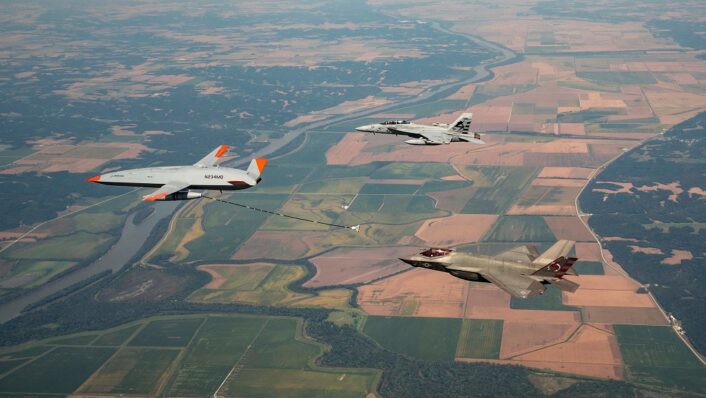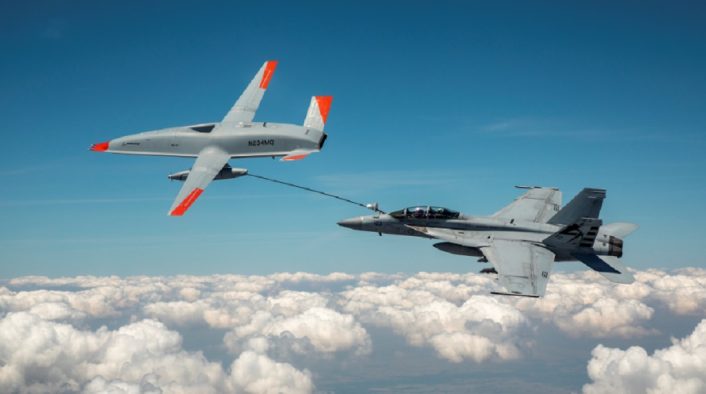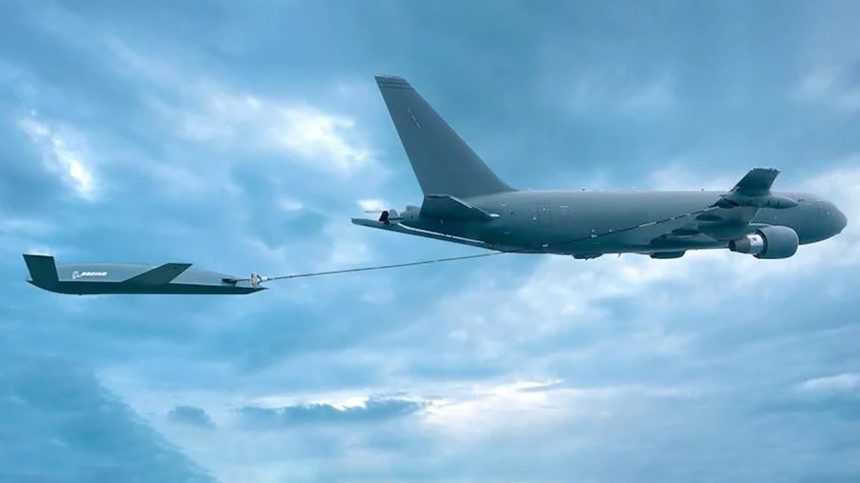Boeing is working on a larger, land-based variant of the MQ-25 Stingray unmanned tanker, which could be able to carry 40% more fuel and refuel drones in contested airspace.
Boeing unveiled, ahead of this year’ Air & Space Forces Association’s Air Space & Cyber Conference which starts on Sept. 16, 2024, a new land-based variant of the MQ-25 Stingray unmanned tanker. The design is being developed internally by the company, but it might be later pitched to the U.S. Air Force as a way to refuel Collaborative Combat Aircraft (CCA) in contested airspace.
Company officials told Aviation Week, which first published the news, that they have been working with the Air Force on this project, although it is not related with the current Next-Generation Aerial Refueling System (NGAS) analysis of alternatives. Aviation Week, however, mentions that NGAS might also include an autonomous tanker for operating in contested environments.
The new land-based design is larger than the standard MQ-25 being developed for the Navy, with the wingspan extended from 75 ft (23 m) to 92 ft (28 m). The increase of the wingspan and the absence of the wing-folding mechanism reportedly allow for a 40% increase of the fuel capacity in the tanker’s wings.
The modifications to the design are limited to the wings, while fuselage, mission systems and engine stay the same. “Boeing looked at six potential redesigns of the wing to increase the aircraft’s capability, settling on the 92-ft. wingspan after thousands of hours of modeling and simulation for both refueling and other mission sets,” mentions Aviation Week.
The possible uses of the new MQ-25 variant
The rendering shared by Boeing shows the MQ-25’s new variant refueling from the KC-46’s Wing Air Refueling Pods (WARP) by using a probe installed on the right side of the nose. The new tanker drone will reportedly initially focus on the hose-and-drogue refueling system.
John Scudi, Boeing’s acting MQ-25 advanced capabilities program manager and senior manager of business development, says the MQ-25 Land Based Variant’s (LBV) use could be targeted toward CCAs, if the designs can include a receiver probe, and Navy fighters. The first increment of CCAs already contracted does not include a refueling capability, however this is among the possible requirements of the next increments.
Scudi further added the LBV’s use is targeted at higher-threat areas where existing tankers would not be able to operate in full safety. A possible mission could see the MQ-25 get its tank topped up from a KC-46 Pegasus tanker and then move forward into a higher-threat area to refuel combat aircraft or CCAs.
Similarly to the Navy’s variant, the new MQ-25 LBV could also assume other roles in addition to refueling, including intelligence, surveillance and reconnaissance (ISR), airborne early warning (AEW) and electronic warfare (EW), says Scudi. The official also mentioned that, thanks to the new wings, the LBV would be able to add two additional 3,000 lb pylon stores that could carry refueling equipment or other systems, including weapons.

The MQ-25 Stingray
The Boeing MQ-25 Stingray is an aerial refueling drone that resulted from the Carrier-Based Aerial-Refueling System (CBARS) program, which grew out of the earlier Unmanned Carrier-Launched Airborne Surveillance and Strike (UCLASS) program.
The genesis of the MQ-25 Stingray traces back to the U.S. Navy’s imperative for a carrier-based unmanned aerial vehicle (UAV) capable of providing aerial refueling to carrier strike groups’ assets. The primary mission of the MQ-25 is to deliver on-demand refueling support, significantly extending the endurance and operational flexibility of carrier-based aircraft.
The MQ-25 Stingray carried out the first ever air-to-air refueling operation between an unmanned tanker and a manned receiver aircraft, (a U.S. Navy F/A-18F Super Hornet) on June 4, 2021. The milestone was achieved by the Boeing-owned MQ-25 T1 test asset flying from MidAmerica Airport in Mascoutah (Illinois) and employing the Cobham Aerial Refueling Store (ARS), the same used by F/A-18s, to perform the refueling operation.
The U.S. Navy is planning to procure more than 70 MQ-25, which will replace the F/A-18E Super Hornets in the aerial refueling role they currently have as part of the Carrier Air Wing, becoming also the first operational carrier-based UAV. This way, the Carrier Air Wing will have more Super Hornets available for operational missions, without the need to reserve some of them for the AAR (Air-to-Air Refueling) mission.
“MQ-25 increases the overall lethality of the CVW by relieving the F/A-18E/F Super Hornet of the aerial refueling mission, enabling ordnance to replace refueling stores on the F/A-18’s pylons. As secondary missions, MQ-25 will conduct recovery tanking and organic intelligence, surveillance and reconnaissance (ISR) to the CSG,” says the website of Unmanned Carrier-Launched Multi-Role Squadron Ten (VUQ-10), the Fleet Replacement Squadron (FRS) for the MQ-25 Stingray, established on Oct. 01, 2022, at Naval Air Station Patuxent River, Maryland.
In addition to VUQ-10, two operational MQ-25A squadrons, VUQ-11 and 12, will be established. Earlier this year, Boeing showcased a new software that allows F/A-18 pilots to control the MQ-25 during the air refueling operations, as part of the development of the manned-unmanned teaming (MUM-T) technology.

The latest developments
In May 2024, Boeing showcased the maturity of software critical for future U.S. Navy operations in a simulator lab, where an F/A-18 pilot remotely commanded an MQ-25 Stingray UAS (Unmanned Aerial System) to perform aerial refueling. The software is part of Boeing’s manned-unmanned teaming (MUM-T) technology.
During the demonstration, using the existing communication links, the pilot sent commands to the MQ-25 to release a refueling drogue and refuel the Super Hornet. The baseline system is designed to be controlled only by the drone’ pilots on the aircraft carrier, while the new software would allow fighter pilots to initiate commands right from their cockpit.
The new software will significantly reduce the time it takes for an F/A-18 to communicate with an MQ-25, giving pilots greater safety and flexibility in refueling operations from longer distances.
In August, the Navy has announced the installation of the first Unmanned Air Warfare Center (UAWC) aboard USS George H.W. Bush (CVN 77). The UAWC will be used by Air Vehicle Pilots (AVPs) to control the MQ-25 Stingray during airborne operations, as well as future unmanned platforms.
The Unmanned Air Warfare Center will act as a carrier-based control room for the unmanned platforms which will integrate in the future Carrier Air Wing. The UAWC includes software and hardware systems that make up the first fully operational and integrated Unmanned Carrier Aviation Mission Control System (UMCS) MD-5E Ground Control Station (GCS).
UMCS is the system-of-systems required for the MQ-25 air vehicle command and control and is critical to the unmanned aircraft refueler’s operations. The GCS was developed by the Navy and integrates the Multi Domain Combat System (MDCX) developed by Lockheed Martin’s Skunk Works, along with additional supporting equipment and hardware.









